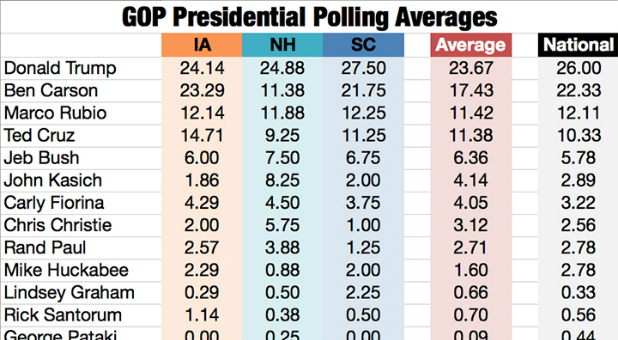Who’s Ahead in Iowa 70 Days out From the Caucuses?
Political polls, despite their flaws, can be useful tools, which is why political operatives still refer to them frequently.
All too often, however, pundits refer to a single poll and use it to paint a narrative that may not be entirely accurate. And then there are the media outlets that manipulate their polls in an effort to alter the course of an election.
Both only further the public perception that polls aren’t to be trusted.
But if one looks at more than just one poll, and from more than one angle—without spin, bias or a narrative in mind—even casual observers can get a true sense of the direction of a particular race. This even applies to the Republican presidential primary race.
This graphic provides the current 30-day averages for the first three states in the nominating process—Iowa, New Hampshire and South Carolina—as well as an average of all those polls, and a 30-day national polling average. These are raw averages from more than 35 polls that are trusted for their relative accuracy and scientific basis.
From the numbers contained therein, there are a few deductions that can be made. These include:
• Four-Man Race—The GOP nomination race has been whittled down to four legitimate contenders: Donald Trump, Dr. Ben Carson, and U.S. Sens. Marco Rubio (R-FL) and Ted Cruz (R-TX). It is difficult to imagine a scenario where any of the other candidates can draw the support necessary to overcome any one of the four.
• The Bush Line—In all three of the early-voting states, as well as in the national polls, former Florida Gov. Jeb Bush is the “cutoff candidate” whereby his support, plus the support of every candidate polling below him combined, is not enough to overcome the other candidates polling above him.
• Carson’s Fade—Contrary to the national media narrative, Carson was never the front-runner. He temporarily leads Trump in Iowa—that will change when a poll that has him above 30 percent ages out—by less than two-tenths of a percentage point, but trails everywhere else. His more recent polling numbers suggest he’s fading, as well.
• Rubio vs Cruz—As Carson fades, Rubio and Cruz are surging. This will be a trend to watch over the coming weeks, as it appears Carson supporters may be switching allegiances. While Trump may benefit a little from such a scenario, Rubio and Cruz are the most likely benefactors of a Carson fade.
Now, those trends are merely useful information, not necessarily the story that armchair politicos should be reading. Rule changes implemented after the 2012 presidential nomination process require all of the states to award delegates proportionately, meaning some candidates who are capable of continuing to campaign may do so, even if they only receive 1 or 2 percent of the vote.
While those delegates may be a small handful by the time the Republican National Convention convenes next summer in Cleveland, in a particularly close nomination battle, they could be powerful bargaining chips for their respective candidates. Delegates could equate to assistance with campaign debts, prime appointments in a future administration or other political favors down the road.















































